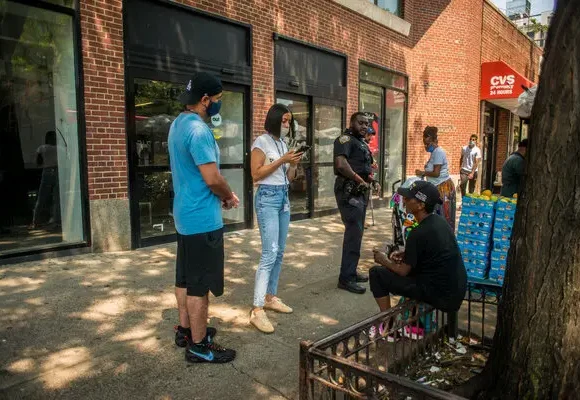Tensions are rising among New York City residents and politicians over the impact of migrant shelters on local neighborhoods. A recent New York Post story revealed that the city’s poorer neighborhoods are bearing the brunt of the migrant crisis, which began about two years ago. Many residents and politicians claim that the influx of migrants is deteriorating the quality of life in these areas.
WOR street reporter Natalie Migliore visited Long Island City (LIC), which hosts no fewer than 23 migrant shelters. She shared her findings on 710 WOR’s Len Berman and Michael Riedel in the Morning program, capturing the sentiments of residents.
One LIC resident expressed his frustration: “It’s just dirty and nasty. It’s definitely much dirtier. You can see; I don’t need to tell you anything; I mean, everybody can see it. They don’t do anything about that, and it’s just unpleasant. You’re walking by every hotel here, and you see them all hanging outside, doing what they want to do. They don’t obey the laws.
This neighborhood has become like hell. It’s dirty, it’s not safe, it’s not fun. My wife and I don’t let her walk the dog outside in the evening. I have to order her a mace; it’s illegal, so now I’m doing something illegal because I believe the police cannot help me out.”
This sentiment of frustration and fear is not isolated. Many LIC residents echo similar concerns about safety, cleanliness, and a general decline in the quality of life. They feel that the rapid increase in migrant shelters has brought about significant changes, not all of which are positive. The visible presence of migrants on the streets and in public spaces has altered the fabric of these neighborhoods, leading to a sense of unease among long-time residents.
Migliore also spoke with a Hispanic woman who has lived in the neighborhood for over thirty years. She expressed her concern about the negative perception cast on all Hispanic people due to the actions of some migrants. “That breaks my heart when I see the news…I said, oh my gosh, they see us like we are all the same, you know. That makes us look really, really bad. So, we hate that. I hate that, you know, when you see the types of things they do. They’re going to say, oh, they all are the same. They do dirty things outside. They don’t behave at all, you know.”
This woman’s perspective highlights a broader issue of stigma and stereotyping that can arise in communities facing sudden demographic shifts. The actions of a few can unfairly color the perceptions of an entire group, leading to division and mistrust. For long-time residents, the changes brought by the influx of migrants are not just about physical cleanliness or safety; they also touch on deeper issues of identity, belonging, and community cohesion.

Local politicians are also voicing their concerns. They argue that the city’s approach to managing the migrant crisis is disproportionately affecting lower-income neighborhoods, which are already struggling with limited resources. The placement of multiple shelters in these areas is seen as an additional burden, exacerbating existing challenges such as crime, unemployment, and inadequate public services.
City officials, however, defend their strategies, citing the need to accommodate a growing number of migrants seeking refuge. They argue that the distribution of shelters is based on logistical considerations and available space, not an intention to target specific neighborhoods. Nonetheless, the perceived inequity in shelter placement continues to fuel resentment and frustration among affected residents.
Community leaders are calling for more balanced solutions, including better resource allocation and comprehensive support programs for both migrants and residents. They emphasize the need for dialogue and collaboration to address the underlying issues and find sustainable ways to integrate newcomers into the community without compromising the quality of life for existing residents.
The growing divide over the presence of migrant shelters in New York City reflects a broader debate about immigration and community resources. As the city continues to grapple with this crisis, the voices of its residents paint a complex picture of frustration, fear, and a longing for solutions. Balancing the needs and concerns of all community members remains a challenging task for city officials. Still, it is a crucial step toward fostering a more inclusive and harmonious urban environment.
Read More News:
Virginia’s Hidden Challenges: Why Some Movers Are Disappointed
Allerton Residents Rescue Abandoned Pitbull, Later Euthanized by ACC After Adoption!


Leave a Reply